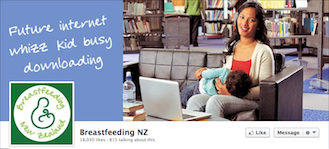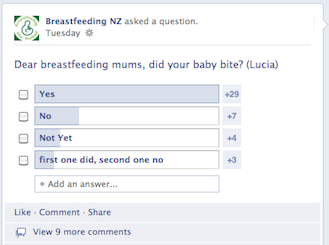With A Little Help From My Friends

The Ministry of Health (the Ministry) seeks to improve, promote, and protect the health of New Zealanders. In 2012, the Ministry’s operational budget was about $205 million. The Ministry can provide or support public health services, such as breastfeeding support.
In August last year, the Department of Internal Affairs looked at the Ministry's work when preparing guidance about social media use. Here, we've updated and expanded on that work, to reflect the Ministry's progress in using social media to support breastfeeding mothers.
Breastfeeding can be difficult and mothers sometimes need support
Breastfeeding does not always come easily to all women. It is important that mothers know what to expect and have ready access to, and support from, health practitioners and other carers.
It can be hard to provide that advice and support at a time and place that is convenient to mothers.
[Social media had the] potential to reach groups less likely to breastfeed.
Research by the National Breastfeeding Advisory Committee1 showed that:
- effective peer counselling can increase the length of time that mothers continue to breastfeed, and the effect is better when the services are delivered at multiple points in time; and
- there was enough evidence about the influence of social marketing on breastfeeding rates to support a campaign designed to address identified social and cultural barriers.
Mothers in lower socio-economic groups and Asian, Māori, and Pasifika mothers have lower breastfeeding rates than other mothers. In 2008, the Ministry decided to try and increase breastfeeding rates among all mothers, but especially among Māori and Pasifika mothers. It also wanted to encourage mothers to continue breastfeeding their babies beyond the minimum recommendation of six months.
What did the Ministry do to promote breastfeeding?
The Ministry spent some time obtaining information on the kinds of support that women in the target groups might want. This involved talking to interested parties and those the Ministry were trying to reach, such as maternity caregivers, Māori, and Pasifika health service providers, health promoters, and breastfeeding mothers.
Drawing on these groups’ collective knowledge and experience, the Ministry created a publicity campaign that ran between 2008 and 2011. The campaign included a series of activities using television, radio, and magazine advertising to help build awareness of the benefits of breastfeeding and try and make it commonplace in New Zealand.
Using social media to promote breastfeeding
The Ministry’s next step was to find a way to build on the initial success of the advertising campaign and keep a connection with breastfeeding mothers. The objective was to extend the support for breastfeeding women into the home and continue to increase community support for breastfeeding mothers.
The role of Community Managers was fundamental to the Facebook page from the beginning.
In 2009, the Ministry launched the Breastfeeding NZ Facebook page (the Facebook page). The Ministry chose social media because of its potential to reach a wide variety of breastfeeding mothers.
To directly connect with breastfeeding mothers and provide a 24-hour support network, the Ministry engaged the same private communications company to help set up, oversee, and maintain the social media aspect of the campaign. The Ministry was aware that, once the campaign was launched, the Ministry would need to resource and support the social media element for a considerable period of time.
The Facebook page stated:
... this page is for anyone and everyone who is breastfeeding, or interested in breastfeeding. You’ll be able to find out more, share your stories and get support from other breastfeeding mums.
To help keep the content of the Facebook page fresh, up to date, and developing in the right direction, the Ministry used Community Managers. Their role was fundamental to the Facebook page from the beginning. The two Community Managers were selected based on their knowledge of both breastfeeding and social media. Their job was to make sure that page content was relevant and respond to questions and issues from users.
 Using information gained from its earlier research, the Ministry gave the Community Managers a list of topics to “seed”, or post, on the Facebook page. These posts stimulated discussion and feedback from breastfeeding mothers, and kept people revisiting the page as the sense of online community and knowledge-sharing grew.
Using information gained from its earlier research, the Ministry gave the Community Managers a list of topics to “seed”, or post, on the Facebook page. These posts stimulated discussion and feedback from breastfeeding mothers, and kept people revisiting the page as the sense of online community and knowledge-sharing grew.
This approach helped to keep the content fresh and ensure that the breastfeeding page continued to meet its core mission. It also helped keep costs down, because the Community Managers were able to use a “little and often” approach, supporting the Facebook page in small amounts of time on a frequent basis.
Did using social media work?
The sense of online community and knowledge-sharing grew.
The Ministry considers that its approach to this project has been successful.
The Facebook page has its own identity and is not “branded” as a Ministry initiative. The Facebook page’s objective was to develop and encourage peer-to-peer support among breastfeeding mothers, and the Ministry felt that putting its own branding on the page might distract from this. The Ministry is identified on the Facebook page as a supporter, but the page has its own logo and character that are independent from the Ministry.
Initial interest in the Facebook page depended on other parts of the project, such as advertising, the Ministry’s own revamped website, and targeted events to stimulate awareness and interest. The Ministry’s wider campaign included supporting initiatives like the “Looking Good Baby” competition. The Ministry found that levels of engagement on the Facebook page increased significantly when baby competitions were running.
The objective was to develop and encourage peer-to-peer support.
In 2012, the “Looking Good Baby” competition yielded almost 13,000 visits to the Facebook page and a “daily social reach” (one of Facebook’s ways of measuing how widely comments spread) of up to 256,000 people. Membership of the Facebook page increased by 30% during the competition, with almost 2,000 new people joining the online community.
When we carried out our work, the Facebook page had a community of around 16,000 people and was still growing.
The Ministry reports a good level of user engagement in the conversations and most posts have some level of interaction (“likes”, comments, and/or subsequent sharing of the content through individual member’s own Facebook pages). In most instances, posts tend to generate comments in the double figures. When a post is highly topical or evokes a direct response, there can be hundreds of comments.
In 2012, the Royal New Zealand Plunket Society reported that breastfeeding rates were improving, with 85% of all babies up to the age of six weeks being breastfed. This was 5% more than the rate for the last 10 years. Within these figures, Māori and Pasifika mothers showed an increase of 2% during the last three years.
Breastfeeding rates were improving.
Although the Ministry credits most of the improvements in breastfeeding rates to the work of frontline health services, promoting and encouraging breastfeeding, its Facebook page offered important additional support to that work.
However, the most important measure of success is the Facebook page’s value to the community it serves and the feedback it generates. In a poll put on the Facebook page, 53% of respondents said that the page had helped them to breastfeed for longer than they expected.
The Facebook page’s success has prompted the Ministry to launch a new engagement tool in 2013 called “live chat”. Mothers can use it to talk directly to an online breastfeeding specialist about issues or concerns they might have. The live chat is also searchable afterwards, increasing its benefit.
The first live chat was watched by 1,800 people and feedback suggests this tool is a very useful form of engagement.
What did it cost?
The Ministry spends less than $200,000 a year on the Breastfeeding NZ campaign, of which the Facebook page is a significant part.
The spending includes on-going support for development (such as competitions), the Community Managers’ time spent posting material and responding to questions, monitoring the Facebook page, and other resources to support breastfeeding mothers. The two Community Managers spend at least six hours a week supporting the Facebook page.
In the Ministry’s view, the benefits have been significant when balanced against the cost.
Lessons learned
The Ministry considered its experience with the Facebook page and identified lessons that it could apply to other projects. In particular: a good relationship with the contractor is vital if an entity is using external expertise; the use of social media needs to be monitored; it is useful to “seed” information; and entities need to learn as they go.
Lessons the Ministry of Health learned from using social media to support and encourage breastfeeding mothers
| Lessons |
|
|---|
1: The National Breastfeeding Advisory Committee (later the National Breastfeeding Committee) was formed in 2006 to provide expert advice and guidance to the Director-General of Health.
